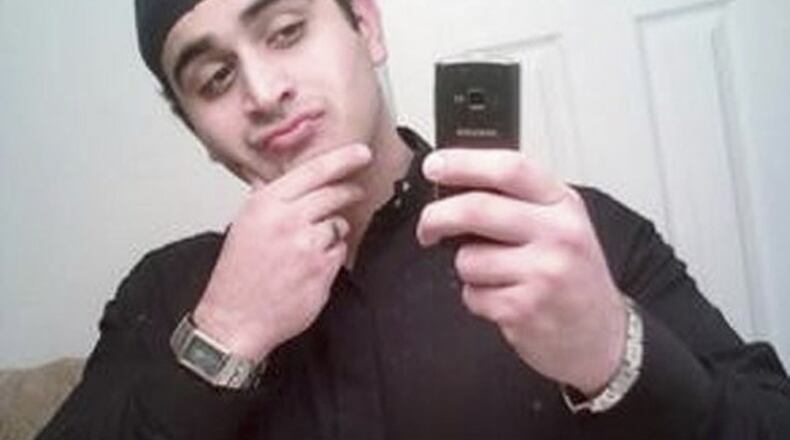Timothy McVeigh in Oklahoma City. Dylann Roof in Charleston. Omar Mateen in Orlando.
Men who committed horrific acts in the name of an ideology.
While their beliefs might differ, what binds them is a shared narcissism — “they want to be big and they want the world pay attention to them,” in the words of one expert — joined with a process of radicalization.
That process might vary from person to person, but all such extremists go through stages of radicalization — often before the very eyes of friends and loved ones — before they act out their rage, experts said.
“In my work, I’ve found that the same people who can be radicalized to join ISIS are similar to the type of people who join a gang,” said Roswell Imam Arshad Anwar. “Why would someone leave their families and communities to join a gang or criminal enterprise? They’re not getting the support and help they need from other places. “
Anwar noted that people who end up radicalized rarely start out as religious. Many, he said, engage in “un-Islamic” behavior such as drinking or drug use before they discover religion. “There’s something going on inside.”
“It’s like they read ‘Islam for Dummies,’” he said. When recruiters approach, they prey more on the person’s emotions than on his religious adherence.
Husband and wife terrorist teams?
Radicalization is a jumble of complex personal reasons and external forces at work, said John Horgan, professor at the Global Studies Institute and Psychology department at Georgia State University.
“Those individual reasons vary from person to person, even within the same group,” Horgan said. “But there’s no single pathway to radicalization.”
The process is sometimes depicted as taking place in a dark room in which a lonely and troubled young person is seduced by ISIS internet recruiters and transforms into a murderous fanatic. But it doesn’t work that way.
“This image of people sitting behind a computer screen and then springing forth a fully formed terrorist, that rarely happens,” said Brandeis University Professor Jytte Klausen, founder of the Western Jihadism Project, which studies Islamic terror groups in the West. “Nearly always there’s some kind of physical contact and someone else encouraging them. I call them ‘pop-up’ cells.”
The part of radicalization that does take part online is usually the beginning of a journey that is rarely solo, said Klausen, who is the author of “The Cartoons That Shook the World,” about the backlash against Danish cartoons of the Prophet Muhammad.
NBC News reported Tuesday that Omar Mateen’s wife, Noor Zahi Salman, had taken her husband to the Pulse nightclub before and had also taken him to buy ammunition. The FBI is investigating how much Salman knew of her husband’s plot and whether she could have been part of it. In another case, just months ago, Syed Rizwan Farook and his wife, Tashfeen Malik, killed 14 people in an attack in San Bernardino, Calif.
As of fall 2015, more than 200 Americans had traveled or tried to travel to Iraq and Syria to join ISIS, according to a report by George Washington University’s Program on Extremism. The report also said, at the time, that there were 900 active investigations against ISIS sympathizers from all ethnic and socioeconomic backgrounds across the nation.
ISIS: ‘A modern, tech-savvy brand’
Internet recruiting, although not the only part of the radicalization process, still is an important component.
“We all know ISIS is trying to recruit young people,” said Anwar on a YouTube video. “One way they’re doing it is through a very, very powerful social media campaign. They’re trying to make an impression. … To young people this might seem cool.”
Once a person starts trying to validate his ideology online, he has no problem finding people in cyberspace who offer step-by-step instructions on how to act it out violently.
“There is a template that’s being pushed online that says you do A, B and C, so in all of these cases there’s implicit coordination,” Klausen said. “He could’ve been communicating with a recruiter on Snapchat, but we just don’t know. I don’t think the FBI even knows right now.”
Houda Abadi, associate director of the Carter Center’s Conflict Resolution Program, said younger people are often a prime target for extremist organizations because of social-political grievances, which include moral outrage, humiliation, marginalization, a search for identity, meaning and a yearning to belong.
“Daesh has developed a modern, tech-savvy brand, enabling its leadership to recruit marginalized youth across digital borders,” Abadi said. (Some refer to ISIS as Daesh.)
“Daesh treats the media battlefield as important as the physical battlefield. Our research has found that their recruitment strategies vary by region, race, gender, and language. Daesh uses cultural and emotional appeals to its targeted audience. Their videos are produced in French, German, Arabic, Russian, English, Spanish, and even local sign language.”
‘No single pathway to radicalization’
The breadth of technology access and rapid communication across social media applications are key components in terrorist recruitment strategy. Daesh digital propaganda videos, she said, have high production values and feature stylistic similarities of Hollywood action movies.
John Horgan, professor at the Global Studies Institute and psychology department at Georgia State University.
“Those individual reasons vary from person to person, even within the same group,” Horgan said. “But there’s no single pathway to radicalization.”
In Georgia, several Muslim organizations have reached out in the community to counter any efforts at radicalization.
CAIR Georgia, for example, has held an anti-extremism seminar to give community members and families the tools needed understand and argue against groups like ISIS and their ideology. Others are planned.
About the Author
The Latest
Featured



